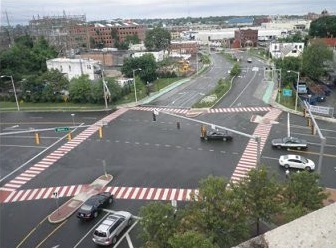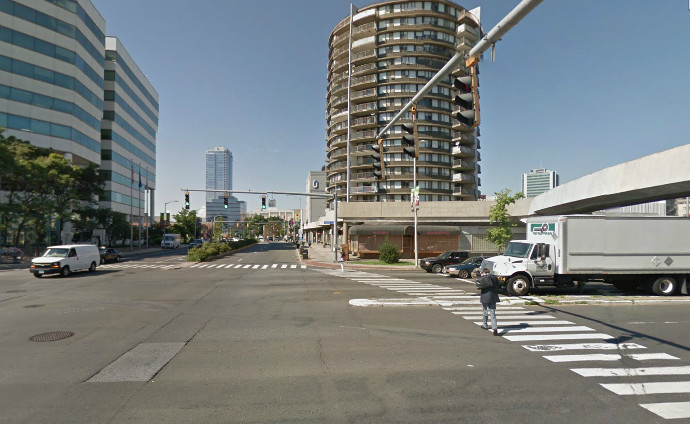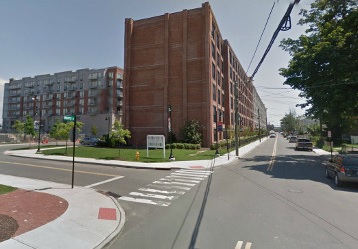
Stamford, Connecticut is a city on the rise — literally. Since 2002, 9,000 housing units have been or are being built, mostly downtown and in the South End, a neighborhood that is south of the city’s transportation center and close to the waterfront. Last year, Stamford grew to over 125,000 residents, passing Hartford to become the state’s third-largest city. The way people get around is changing, too, which is why as the City goes through a Master Plan process, it must change its streets as well.
The Stamford Transportation Center, which is the busiest rail station on Metro-North’s New Haven Line and also hosts Amtrak and CTTRANSIT buses, has been an anchor for the city. In 2000, 7 percent of Stamford workers took transit to work and 2.7 percent walked. According to 2006-10 data from the American Community Survey, 10.6 percent of workers in the city now take transit; 4.5 percent walk to work. (Many of the transit commuters ultimately walk from the station to their office.)
But the walk between the transportation center and downtown leaves much to be desired. While the walk north is pleasant in spots, people must confront intersections like this one, at Washington and Tresser Boulevards:

Similar issues mar the walk to the South End:

Unfortunately, the city doesn’t appear to have a comprehensive complete streets plan, and has addressed increasing pedestrian and bicycle access on an ad-hoc basis, making occasional budget appropriations for traffic calming.
Residents clearly want to see more from the city. At the city’s first Master Plan workshop in May, participants broke into six roundtables to discuss topics like the economy, land use, housing and open space. The need for more walkable streets and better bike connections was brought up at almost every one. Participants said that a better walking environment around the train station would help the economy, and that better biking and walking connections were needed within neighborhoods and between parks. At the transportation table, “several participants described the pedestrian experience in Stamford as both intimidating and unsafe,” according to consultant BFJ Planning.
Stamford also has a growing pedestrian and bicycle advocacy community, with citizen groups like People-Friendly Stamford (an initiative of Reinventing Stamford) leading the charge. And Mike Norris, a member of People-Friendly Stamford and the state’s Bicycle and Pedestrian Advisory Board, is making street design an issue in this year’s Stamford Mayoral campaign. Last week Norris biked with Stamford mayoral candidates Michael Fedele and William Tong, and he says he has a commitment for a future ride with mayoral candidates David Martin.
But Stamford can’t do it alone. The State also has a role to play. Some of the most intimidating intersections in the city, like the Washington-Tresser intersection, involve state roads. ConnDOT also has nearly complete control over a new transit-oriented development project which will add mixed-use buildings and additional parking near the transportation center. The location is right for development, but many details have been kept secret. ConnDOT and the new developer must go the extra mile to reduce automobile use by providing transit, walking and bicycle incentives in and around the project.
As it continues to grow, one city Stamford might look to for guidance is Hoboken, New Jersey. Like Stamford, Hoboken has grown around its rail stations, has attracted young professionals, and deals with congestion. Hoboken has met the challenge by providing transportation options, including car-share, bike-share, new bike lanes, shuttle service, and incentives for residents who go car-free.

It is very important that the city plans include the safety of individuals residing in the city. To avoid bicycle crash, a proper path or diversion should be made so that it becomes safe for riders to ride their bicycles. In many of the cities there are some great local street & roads plans considering the safety of the individuals.
The only cross street in Stamford is Route 1 (East Main Street/Tresser Blvd/West Main Street), there should be another further North but south of the Merritt Parkway.
There should be more zebra stripes at crosswalk east/west as well as north/south. When cars/trucks/buses come to a stop sign they should be required to stop
Sidewalks should be wide enough for people to walk in both directions without going into street and bikes should not be ridden on sidewalks.
More pedestrian traffic lights with countdown should be available.
Enforcement of laws should be required to make pedestrians and bikers safe.
I was a passenger in a car yesterday returning from the south end and the driver could not even FIND the train station. The highway and elevated train tracks wall off that neighborhood from downtown, providing few visual clues. Stamford is an object lesson in the downside of auto-centric urban planning. It is way past time for the city to devise a way to fix what was broken,and try to make it once again a desirable place.
We can’t just banish cars. The vast majority of people who use the Stamford train station to commute to jobs in NYC or other points drive to the station. They may arrive by taxi, by their own car that they park at the station or get dropped off.
The traffic calming that was done with the last station re-design has choked off traffic and made navigation impossible during busy drop off/pick up hours.
The safety for pedestrians around the station should be focused on crime and not removing cars.
If you want to get drivers off of 95 and the Merritt, you need to offer east access and plenty if parking. The vast majority of housing stock in Stamford is not accessible to the station by walking – it’s mostly single family houses miles away.
T.O.D. is a scam and so was the selection process for a design and developer of this project. Everything done in secret behind closed doors. That’s absolutely no way to plan for the future of the city.
I suggest a close look at the relationship between the developer and anyone involved in this in City and State government. These partnerships are wholesale theft from citizens. No oversight, no accountability, no transparency. ConnDOT is complicit in handing our future away to developers.
There’s a fight brewing over this project, expect delays and costly overruns. Ignore the people and money-pit is what you’ll get.
Though I have not had to commute, either to or from Stamford the distance and time taken to arrive by car is lengthy and difficult. Former Mayor Dan Malloy realizes some companies have either not come to Stamford, or have left due to commuting difficulties. I believe making the Trains and City Bus, as well as walking more safe would lessen the number of cars on the road.
Helping Pedestrians be able to go and come with more ease would help businesses downtown as well. This means drivers knowing and paying attention to the Right of Way in Cross Walks for Pedestrians. There are a good number of hazardous intersections, where many main streets come together.
Sincerely,
Leslie Weinberg
lesweinberg@optonline.net
C 203-517-8496
11 Big Oak Circle
Stamford, CT 069903